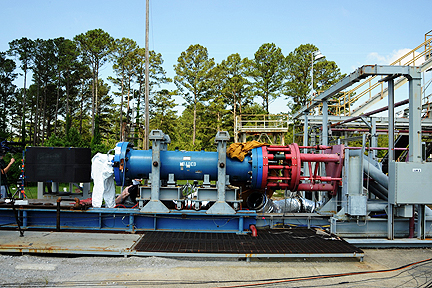 This 24-inch-diameter, 109-inch-long motor used propellant and a case reconfigured from space shuttle test equipment. The test motor's nozzle was replaced with a new design scaled from the Ares I first-stage development motor, but could also be modified to accommodate different mission profiles or different sized vehicles, including heavy-lift vehicles. The test data will be evaluated to better understand the performance of the new nozzle configuration, processes and materials. "A rocket's nozzle needs to be protected from the incredibly harsh environment to which it is exposed during launch. A full-scale solid rocket motor's nozzle must survive a two minute launch at over 5000-degrees Fahrenheit," said Scott Ringel, an engineer at the Marshall Center and the design lead for this test. "We need to ensure our materials and designs can hold up, and small-scale tests like this one give us added confidence."
This 24-inch-diameter, 109-inch-long motor used propellant and a case reconfigured from space shuttle test equipment. The test motor's nozzle was replaced with a new design scaled from the Ares I first-stage development motor, but could also be modified to accommodate different mission profiles or different sized vehicles, including heavy-lift vehicles. The test data will be evaluated to better understand the performance of the new nozzle configuration, processes and materials. "A rocket's nozzle needs to be protected from the incredibly harsh environment to which it is exposed during launch. A full-scale solid rocket motor's nozzle must survive a two minute launch at over 5000-degrees Fahrenheit," said Scott Ringel, an engineer at the Marshall Center and the design lead for this test. "We need to ensure our materials and designs can hold up, and small-scale tests like this one give us added confidence."
NASA is a unique customer for many materials and requires highly reliable systems, thoroughly tested and evaluated for human spaceflight programs. One change in the availability of a part, supplier or material can potentially impact vehicle design, flight operations and mission assurance. Finding adequate replacements involves extensive testing and qualification efforts. Testing a sub-scale version of a rocket motor is a cost-effective way to assess new materials, technologies or processes, and rapidly evaluate performance.
The test also includes two secondary objectives. The engineering team introduced an intentional defect into the propellant. A small cut was placed in the propellant inner diameter to verify the analytic methodology used to determine critical flaw sizes. The team hopes to gain a better understanding for the margin for error. In addition, NASA's Engineering and Safety Center will use data gleaned from this test to better understand the acoustics and vibration environment resulting from the rocket motor's plume. Engineers from the Marshall Center's Engineering Directorate designed the test article with support from ATK Aerospace Systems of Huntsville, Ala.

